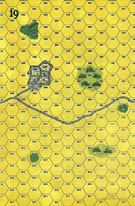|
Bloody Quagmire Road to Berlin #59 |
||
|---|---|---|
| (Defender) Germany | vs | Soviet Union (Attacker) |
| Formations Involved | ||
|---|---|---|
| Germany |  |
32nd SS Panzerjäger Battalion |
| Germany |  |
88th SS “Becker” Grenadier Regiment |
| Soviet Union |  |
362nd Rifle Division |

|
| Overall Rating, 2 votes |
|---|
|
3
|
| Scenario Rank: --- of 940 |
| Parent Game | Road to Berlin |
|---|---|
| Historicity | Historical |
| Date | 1945-04-16 |
| Start Time | 03:00 |
| Turn Count | 48 |
| Visibility | Day & Night |
| Counters | 77 |
| Net Morale | 1 |
| Net Initiative | 2 |
| Maps | 2: 18, 19 |
| Layout Dimensions | 86 x 28 cm 34 x 11 in |
| Play Bounty | 109 |
| AAR Bounty | 171 |
| Total Plays | 2 |
| Total AARs | 1 |
| Battle Types |
|---|
| Urban Assault |
| Conditions |
|---|
| Off-board Artillery |
| Reinforcements |
| Scenario Requirements & Playability | |
|---|---|
| Road to Berlin | Base Game |
| Introduction |
|---|
|
To the southeast of Berlin, the Soviet 33rd Army had the task of trying to draw German reserves to its non-vital sector of the Oder River line. With much less armor and artillery support than the other armies driving toward the Nazi capital, thanks to the area's swampy ground, the Soviets could not expect to sustain a serious drive. On the other side of the line, the third-rate German forces could not expect to hold their lines. A resistible force was about to meet a movable object. |
| Conclusion |
|---|
|
The town of Wiesenau changed hands an astonishing 28 times in the course of a single day, as the Red Army and the SS threw each other out of the battered rubble over and over again. One of the worst units on the front, the 88th was formed from various scrapings of SS training schools and had never been declared combat-ready (how any group of armed men could fail to receive that designation at this late date is hard to fathom). |
| AFV Rules Pertaining to this Scenario's Order of Battle |
|---|
|
| 4 Errata Items | |
|---|---|

|
The movement allowance on the counters in Airborne is misprinted. It should be "3." (rerathbun
on 2012 Jan 30)
|

|
All SS 75mm IG guns are direct fire weapons (black), not indirect (white). (Shad
on 2010 Dec 15)
|

|
The reduced direct fire value of the SS HMG is 5-5 in Beyond Normandy and Road to Berlin. (plloyd1010
on 2015 Jul 31)
|

|
The reduced direct fire value in Kursk: Burning Tigers is 4-4. (plloyd1010
on 2015 Jul 31)
|
| Road to Berlin #59 | ||||||||||||
|---|---|---|---|---|---|---|---|---|---|---|---|---|
Both sides were hampered by poor set ups. The Germans would have done better to deploy the AT guns and some troops further back by the small town and clump of woods on board 18. Instead, the AT guns were deployed further up where they were assaulted and destroyed early in the game. The Soviets were somewhat poorly organized during their approach, but where also affected by consistently bad rolls. By the 0630 turn, they had only inflicted 4 step losses. The artillery in particular seemed to continually get no effect results. The German lines were holding up well and for a bit I was thinking the Soviets wouldn't have the necessary troops to dislodge the Germans from the towns. About 0730 the line cracked and collapsed quickly. A single grenadier stand held out in the woods for several hours of combat but eventually was destroyed by compound morale failure (They rolled a 12!). Other than that, the Soviets held the 2 large woods and large town by about 0900. Most of the game was spent fighting out 3 or 4 large assaults at a time. I ended the game early at 1030 since the Germans were down to only 3 units versus 20 or so Soviets. The Hetzers never showed up, had they shown up early in the, they would have made life difficult for the Soviets since they have very little in the way of AT weapons. As is was, even if they had shown up near when I ended the game, they would have had to dislodge the Soviets from 3+ town hexes without infantry support. |
||||||||||||
| 0 Comments |

 RtBr058
RtBr058 





















